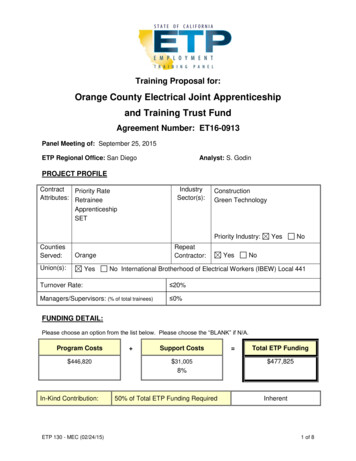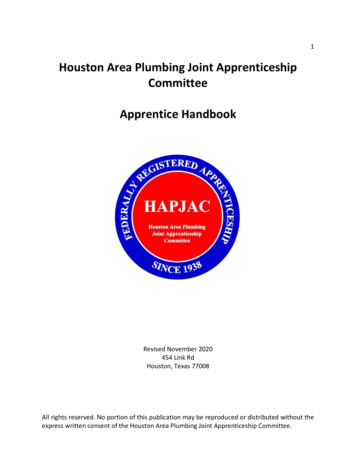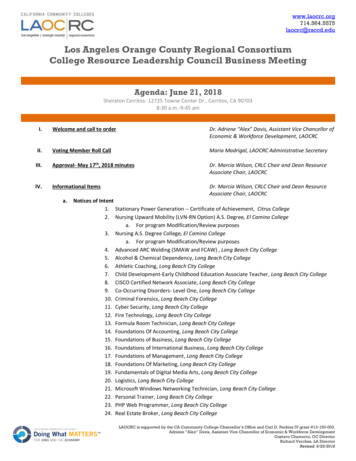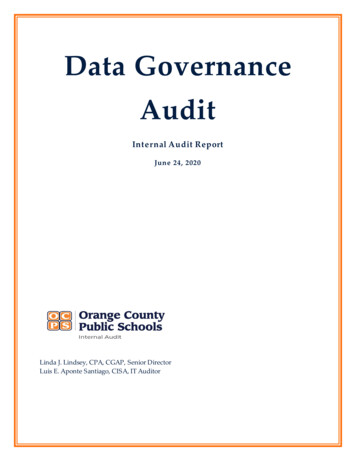
Transcription
Training Proposal for:Orange County Electrical Joint Apprenticeshipand Training Trust FundAgreement Number: ET16-0913Panel Meeting of: September 25, 2015ETP Regional Office: San DiegoAnalyst: S. GodinPROJECT PROFILEContractPriority RateAttributes: uctionGreen TechnologyPriority ntractor:YesYesNoNoNo International Brotherhood of Electrical Workers (IBEW) Local 441Turnover Rate: 20%Managers/Supervisors: (% of total trainees) 0%FUNDING DETAIL:Please choose an option from the list below. Please choose the “BLANK” if N/A.Program Costs 446,820In-Kind Contribution:ETP 130 - MEC (02/24/15) Support Costs 31,0058%50% of Total ETP Funding Required Total ETP Funding 477,825Inherent1 of 8
Orange County Electrical Joint Apprenticeshipand Training Trust FundSeptember 25, 2015ET16-0913TRAINING PLAN TABLEJobNo.12Job DescriptionType of TrainingCommercial Skills,Business Skills,Computer Skills,ContinuousImprovement,OSHA 30CommercialSkills,OSHA 10RetraineeJourneymanPriority RateSETRetraineeApprenticeSETRange ofEstimatedHoursNo. ofTrainees Class / CBTLab508-2000AveragePostCost per RetentionTraineeWage 564 29.92 2,725 20.55Weighted Avg:241658-2100Weighted Avg:196Minimum Wage by County: 20.55 per hour for SET Statewide priority industry.Health Benefits:YesNoThis is employer share of cost for healthcare premiums –medical, dental, vision.Used to meet the Post-Retention Wage?:YesNoMaybeUp to 4.10 per hour will be used to meet the required SET priority industry wage of 20.55 perhour in Job Number 2.Wage Range by OccupationOccupation TitlesJob Number 1: JourneymanInside WiremanTransportation Systems InstallerSound TechnicianJob Number 2: ApprenticeInside WiremanTransportation Systems Installer3rd year Sound Technician* Wages vary by union local.Wage RangeEstimated # ofTrainees5030155165100653INTRODUCTIONCreated in 1950, the Orange County Electrical Joint Apprenticeship and Training Trust Fund(OC/TTF or Trust) (www.ocett.org) is administered jointly between the Orange County Chapterof the National Electrical Contractors Association (NECA) and the International Brotherhood ofElectrical Workers (IBEW) Local 441. The Trust is located in Santa Ana. Its mission is toETP 130 - MEC (02/24/15)2 of 8
Orange County Electrical Joint Apprenticeshipand Training Trust FundSeptember 25, 2015ET16-0913provide up-to-date industry skills training and secure high-quality job opportunities forJourneymen and Apprentices in three electrical occupations.At present, the OC/TTF serves approximately 1,200 Journeymen and 189 Apprentices. TheTrust administers funds for three apprenticeship programs under two different JAC’s:Orange County Electrical JAC Inside WiremanIntelligent Transportation SystemsOrange County Sound Technician JAC Sound InstallerApproximately 191 employers are signatory to the three collective bargainingagreements. These employers perform specialized construction work related to thedesign, installation and maintenance of commercial and residential electrical systems.This is the third agreement between ETP and OC/TTF in the last five years. The Trust reportsthat as a result of ETP funding it graduated seven apprentices in 2013 and 67 apprentices in2014. OC/TTF anticipates that 42 apprentices will graduate in 2015. Both the Inside Wiremenand Transportation Systems apprenticeship programs are five years, and the Sound TechnicianInstaller program is three years, in duration.PROJECT DETAILSEmployer Demand for TrainingSignatory employers and union representatives have identified the following reasons forJourneymen training: new energy efficiency regulations, the need to reduce costs to remaincompetitive, higher quality standards, the increasing complexity of construction projects, and aretiring workforce in Orange County. OC/TTF will provide training to workers for commercial,industrial and residential projects with local signatory contractors.Current and upcoming Orange County construction projects include:BroadcomCommercial/Industrial Complex; Irvine Company 20 story high rise office building; EnergyCenter Gas Turbine Plant; Yorba Linda Power Plant; Source Complex Buena Park Hotel & highrise office building; San Clemente Retail Plaza; Newport Mesa School District SolarizationProject; multiple Kaiser Hospital solarization projects and numerous smaller commercialprojects.Apprenticeship ProgramThe Panel is authorized to fund Apprentice training that does not displace any other source ofgovernment funds, or replace an existing apprenticeship program approved by the Division ofApprenticeship Standards (DAS). The Panel adopted the Apprenticeship Training Program as apilot in March 2012. It is designed to supplement cost of delivery for the Related andSupplemental Instruction (RSI) portion of DAS-approved apprenticeship training.Apprenticeships are a multi-year training program that results in DAS certification to work as aJourneyman. They are authorized in California under the Shelly-Maloney Apprenticeship LaborStandards Act of 1939. Apprentices commit to training under contract with an apprenticeshipETP 130 - MEC (02/24/15)3 of 8
Orange County Electrical Joint Apprenticeshipand Training Trust FundSeptember 25, 2015ET16-0913program sponsor. They advance through a series of apprenticeship levels as they completemodules of RSI and on-the-job training. Wages are paid for hours worked on the job, inprogression with a series of advancements up to the Journeyman level.Apprentice programs are typically sponsored by a Joint Apprenticeship Training Committee(JATC) as here. A JATC is created through collective bargaining, with an equal number ofmembers appointed by union and management contributions to a training trust fund. Theemployers are not “participants” but are signatories to the Collective Bargaining Agreement.Depending on the type of trade, apprenticeship programs vary in length. As noted earlier, herethere are two five year programs and one three year program. They also vary in size, rangingfrom less than 10 to several hundred apprentices at any given point in time. Several types oftrainees are eligible under the Apprenticeship Program:Apprentices (second-year),Journeymen and Pre-Apprentices. First-year Apprentices are not eligible due to the higherdrop-out rates associated with this entry-level.RSI is traditionally delivered as class/lab, and ETP does not reimburse CBT delivery forapprenticeship training. The curriculum is developed with input from DAS and a designatedLocal Educational Agency; in this proposal the LEA is Palomar Community College. TheApprenticeship Program allows reimbursement for up to 200 hours of RSI plus OSHA10, perapprentice.For the building trades, it is not customary for workers to be employed for a standard retentionperiod of 90 consecutive days with one employer. In that instance, the Panel may substitutenon-consecutive hours worked for retention. This modified retention period must be no lessthan 500 hours within 272 days with more than one employer. Both the standard and modifiedretention periods will apply to this proposal.Because ETP funding cannot displace another source of government funds, the fixed fee rate isreduced by 5.00 to account for adult education funding appropriated each year for Apprenticetraining through the California Community College Chancellor’s Office and Department ofEducation. This changes the ETP Priority Industry Rate from 18.00 to 13.00 per hour for allApprentice Job Numbers.In addition, the Panel adopted a “blended rate” for Journeymen, reflecting the fact that they maybe employed by a variety of contractors over the two-year term of contract ranging from largeemployers, to small ( 100 employees). This is 22 per hour, midway between the PriorityIndustry standard rate ( 18) and Small Business rate ( 26).Under the Apprenticeship Training Program, the post-retention wage has been standardized to 20.55 per hour reflecting the Special Employment Training (SET) wage for Priority Industry.This wage was chosen for ease of administration, recognizing that most Apprentices and allJourneymen exceed the highest ETP wage requirements. However, if the actual rate is higher,it will be used, as is true here for Journeymen.ETP 130 - MEC (02/24/15)4 of 8
Orange County Electrical Joint Apprenticeshipand Training Trust FundSeptember 25, 2015ET16-0913DAS Completion RatesThe average completion rate for Apprentices in the Electrical Industry is 66.3% as measured byDAS over the most recent five-year reporting period (CY2009 through CY2013). The DAScompletion rates for OC/TTF were 65.75% for its Inside Wiremen and Transportation Installersand 61.79% for its Sound Installers, both of which exceed the benchmark of no less than 50% ofthe industry average.Training PlanOC/TTF will provide its journey workers with OSHA 10/30 and a variety of Business, Commercialand Computer skills training topics included in the Agreement’s menu curriculum. Apprenticeswill receive Standard Related and Supplemental Instruction (RSI) in addition to OSHA 10. Alltraining is center-based and will be delivered at the Trust’s training center in Santa Ana.Journeyman TrainingCommercial Skills (80%)Green training is expected to be the centerpiece of the program because of the demand forenergy efficient construction methods and technologies by participating employers and propertyowners. Training will cover energy-efficient technologies and products such as green buildingmaterials, solar photovoltaic panels, new motor controls, advanced welding, green materialstesting and audit equipment.OC/TTF will also offer a new journey level certification class: Instrumentation. TheInstrumentation class is a joint Electrical and Pipefitter class teaching electricians how tocalibrate and install electrical wiring in pipes. The course is critical for journeymen working inhigh industrial areas and in water treatment plants.Business Skills (5%) - Electricians must understand new national building codes and greenpractices; follow certification guidelines; use more collaborative bidding and project developmentpractices; meet budgets; interact with other types of construction workers; and implement greensolutions in traditional work environments. The proposed training will give trainees the tools toplan, organize, and manage construction projects more efficiently. Training will also includeteam-building and leadership skills so that electricians can lead teams in an effective andefficient manner.Computer Skills (5%) - Training will include scheduling, planning and modeling software andAutoCAD and Job Tracking applications that provide trainees with the tools to modify blueprints,look up project requirements, build budgets and timelines, design virtual buildings, and adjustcomputerized control systems.Apprenticeship TrainingCommercial Skills (95%)Inside Wiremen and Transportation System Installer Apprentices learn to install, maintain andrepair various types of electrical and electronic equipment in commercial, industrial andresidential establishments. They will also learn to install connect and test: electrical wiringsystems for lighting, heating, air conditioning and communications in any building or structure.ETP 130 - MEC (02/24/15)5 of 8
Orange County Electrical Joint Apprenticeshipand Training Trust FundSeptember 25, 2015ET16-0913Sound Installer Apprentices learn to install, maintain and repair limited energy monitoring,communication and signaling systems. These may include: fire alarm, telephone, computernetworks, access control, security, closed captioned television (CCTV), video sound systemsand other signal, traffic, and communications systems.Certified Safety TrainingOSHA 10/30 (10% Journeymen; 5% Apprentices) – OSHA 10/30 training is a series of courses“bundled” by industry sector and occupation. It consists of 10 hours of training for Apprenticesand 10 or 30 hours for journeymen. The coursework is geared towards construction work, andalso manufacturing. Completion of the training results in a certificate that expands employmentopportunities. The coursework must be approved by Cal-OSHA, and the instructors must becertified by Cal-OSHA. This training provides a complete overview of occupational safety andhealth so that workers are more knowledgeable about workplace hazards.Green TechnologyTraining will cover energy-efficient technologies and products such as green building materials,solar photovoltaic panels, new motor controls, climate energy efficiency and green materialstesting and audit equipment. This training will help electrical workers hone the new skills andknowledge necessary to work in green construction in the Orange County area.Curriculum DevelopmentThe Apprentice program uses the National Joint Apprenticeship and Training Committee’sCurriculum which was developed for the exclusive use of IBEW-NECA. The Journeymanupgrade Curriculum is employer-driven to meet the needs of signatory Orange Countyemployers. The Curriculum was developed and customized with input from both labor andmanagement representatives to address the local needs of union members, participatingemployers, and the industry as a whole.Trainer QualificationsOC/TTF employs a total of 15 full and part-time trainers. All trainers are former or currentmembers of the trade and some have received Master Certification status by the National JointApprenticeship and Training Committee. All trainers are approved by Santiago Canyon College.Marketing and Support CostsOC/TTF conducts marketing through direct mailings, informational flyers, personal contacts,telephone calls, public service announcements, emails, and its website. Class information isdisseminated throughout the year to all apprentice and journeyman electricians within thejurisdiction, as well as to the electrical contractors who employ them.Application announcements for the Apprenticeship program are disseminated to local, state andfederal agencies as well as to local high schools and community colleges; and community basedorganizations.Four staff persons in the OC/TTF office will assist with marketing, recruitment, needsassessments, and scheduling of classes. The Trust requests 8% support costs to fund its staffin recruiting and qualifying additional participating employers for this program.Manyparticipating employers have already been recruited; however, additional recruitment andassessment activities are anticipated. Staff recommends the 8% support costs.ETP 130 - MEC (02/24/15)6 of 8
Orange County Electrical Joint Apprenticeshipand Training Trust FundSeptember 25, 2015ET16-0913Commitment to TrainingEmployers will continue to make contributions to the training trust for every hour worked byApprentices and Journeymen. General safety training is provided by the signatory employers inaccordance with all pertinent requirements under state and federal law.Impact/OutcomeOC/TTF offers certification classes in topics such as Green Audits, Arc Flash Safety Awareness,OSHA 10/30, Instrumentation, Electric Vehicle Infrastructure (EVIT) and California AdvancedLighting Control Program (CALCTP).Retention ModificationFor occupations in which workers are hired for short-term jobs, retention may be satisfied byemployment of at least 500 hours within 272 days; or alternatively, full-time at 35 hours perweek with one employer for 90 consecutive days.Tuition ReimbursementOC/TTF represents that students enrolled in the ETP-funded program will not be charged tuition,fees, or any other costs associated with training. This representation will be made a condition ofthe Agreement.RECOMMENDATIONStaff recommends approval of this proposal.ACTIVE PROJECTSThe following table summarizes performance by OC/TTF under an active ETP Agreement:Agreement letedTrainingNo. RetainedET14-0918 335,2995/05/14-5/04/1625434171The Trust reports that training under this Agreement was completed by 6/11/15. The ETP tracking systemshows that 26,419 eligible reimbursable hours have been delivered to 341 trainees. This equates to 412,449, more than 100% of the Agreement amount. The Trust anticipates close-out of this Agreementby CY 2015.PRIOR PROJECTSThe following table summarizes performance by OC/TTF under a previous ETP Agreement thatwas completed within the last five years:ETP 130 - MEC (02/24/15)7 of 8
Orange County Electrical Joint Apprenticeshipand Training Trust FundSeptember 25, 2015ET16-0913Agreement No.Location(City)TermApprovedAmountPayment Earned %ET13-0903Santa Ana09/04/12-09/03/14 336,789 336,789 (100%)DEVELOPMENT SERVICESCalifornia Labor Federation in Sacramento and Strategy Workplace in Oakland assisted with thedevelopment of this proposal at no cost.ADMINISTRATIVE SERVICESStrategy Workplace will also perform administrative services in connection with this proposal fora fee not to exceed 13% of payment earned.TRAINING VENDORSNoneETP 130 - MEC (02/24/15)8 of 8
Orange County Electrical Joint Apprenticeshipand Training Trust FundET16-0913Exhibit B: Menu CurriculumTrainees will receive any of the followingClass Lab Hours8-200 (Job 1 Journeyman)COMMERCIAL SKILLSCodeology National Electrical Code Other Recognized Standards (Installation Changes) Plan, Build, and Use Related Standards (Mandatory and Permissive Rules) Special Occupancies and Equipment Arc FlashAnalog/Digital Circuit (AC/DC) Principles Math for Electricians Ohm’s Law Generators Inductance/Reactance Series/Parallel CircuitsGrounding Grounding and Bounding National Electrical Code Article 100-Definitions and Provisions National Electrical Code Article 110-Requirements National Electrical Code Article 90-Introduction National Electrical Code Article Chapters 1-4 Significant Changes to National Electric CodeFire Alarm Systems and Installations Definitions and Systems Initiating Devices and Notification Systems National Electrical Code and Installation Requirements Start Up and Check Out Procedures National Fire Protection Act, 1972 (NFPA 72)Fire Life Safety National Electrical Code (Relating to Fire Alarms) National Electrical Code Article 725 National Electrical Code Article 760 NFPA 72 Principles of ElectronicsETP 100 Exhibit B Menu Curriculum (07/07/14)1 of 6
Orange County Electrical Joint Apprenticeshipand Training Trust FundET16-0913Industrial Motor Control Control Relays and TimersJogging and Plugging ControlsManual Starters and Magnetic CoilsPush Buttons, Selector Switches, and Mechanical DevicesSolid State Electronic DevicesVariable Frequency DrivesProgrammable Logic Control (PLC) Developing Ladder Programming Introduction to Programmable Equipment Programming Programmable Logic Controllers Using Timers and Counters in Logic Programs Writing a ProgramElectrical Design 3 and 4-Way Switching Design of Electrical Circuits Magnetic Motor Control and the Code LonWorks and Building Automation Transformers and the CodeVoice, Data, and Video Audio Distribution CCTV Security Surveillance Computer Networking Fiber Optics Telephonic InterconnectIndustry Specific Skills Solar Panel Installation Solar Photovoltaics Building Automation Systems Confined Space Entry Specialized Tools Conduit Bending Rigging and Lifting Firestop Installation Blueprints and Schematics Work Flow and Resources Proper Installation and Use of Testing and Auditing Materials and Equipment(Green Training) Understanding New Technologies and Changes to Industry Standards (GreenTraining) Proper Equipment Set-Up (Green Training)ETP 100 Exhibit B Menu Curriculum (07/07/14)2 of 6
Orange County Electrical Joint Apprenticeshipand Training Trust Fund ET16-0913Safe Working Practices (Training is capped 10% of a trainee’s total hours)Advanced Instrumentation and Motor ControlsProgrammable Logic ControllersAdvanced WeldingArchitecture Designs and Advanced Plan ReadingManagement and Monitoring of Mat
Orange County Electrical Joint Apprenticeship and Training Trust Fund September 25, 2015 ET16-0913 ETP 130 - MEC (02/24/15) 3 of 8 provide up-to-date industry skills training and secure high-quality job opportunities for Jo











